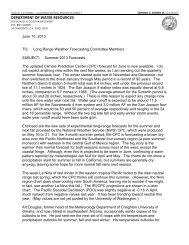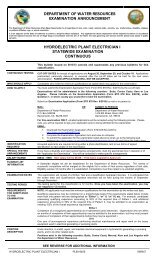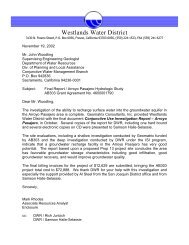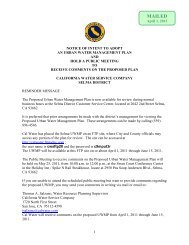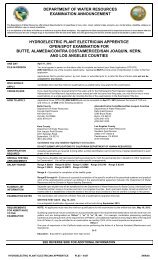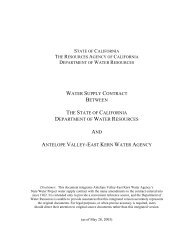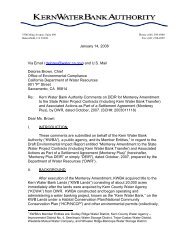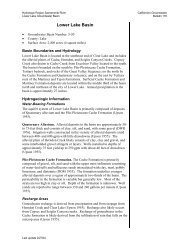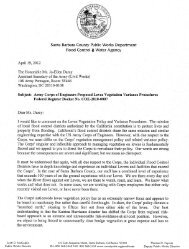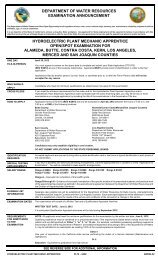Bulletin 1.pdf - California Department of Water Resources - State of ...
Bulletin 1.pdf - California Department of Water Resources - State of ...
Bulletin 1.pdf - California Department of Water Resources - State of ...
Create successful ePaper yourself
Turn your PDF publications into a flip-book with our unique Google optimized e-Paper software.
WATER RESOURCES OF CALIFORNIA 537<br />
FLOOD FLOWS<br />
Floods in streams and dry washes <strong>of</strong> the Colorado Desert Area are<br />
generally local in nature. While damage resulting from them has occasionally<br />
been severe, it has been mainly limited to highways and railroads,<br />
and to canals in the Imperial Valley. Principal cause <strong>of</strong> these<br />
local floods has been summer cloudbursts. Because <strong>of</strong> lack <strong>of</strong> available<br />
data, no studies <strong>of</strong> flood frequencies in the Area have been attempted<br />
during the present investigation. Flood flows in Colorado River are<br />
related to the entire Colorado River Basin and are discussed generally<br />
in Appendix E.<br />
As a matter <strong>of</strong> historical interest, a flood <strong>of</strong> great magnitude in the<br />
Colorado Desert Area resulted in 1905 and 1906 from an uncontrolled<br />
diversion from Colorado River into Imperial Valley. On May 17, 1904,<br />
the <strong>California</strong> Development Company, through a Mexican subsidiary,<br />
"La Sociedad de Reigos y Terrenos de la Baja Oalifornia," was granted<br />
a right by the Mexican Government to convey through Mexico, to the<br />
United <strong>State</strong>s, water diverted in the United <strong>State</strong>s or in Mexico and, in<br />
addition, a right to divert 10,000 second-feet <strong>of</strong> water from the Colorado<br />
River in Mexico for such purpose.<br />
Because <strong>of</strong> physical difficulty experienced in diverting water from<br />
the Colorado in the United <strong>State</strong>s, two dredger cuts were made from the<br />
river in Mexico to accomplish this diversion. The cuts extended to the<br />
Alamo Canal, also known as the Imperial Canal, and the first was immediately<br />
below, and the second about four miles below the International<br />
Boundary. Pending approval by the Mexican Government <strong>of</strong> the right to<br />
install control gates in these cuts, none was constructed, but water neverthe<br />
less was diverted into Alamo Canal. Unprecedented floods from<br />
Gila River in Arizona during the winter <strong>of</strong> 1904-05 made closing <strong>of</strong> the<br />
lower cut imperative, but efforts to do this were unavailing. This cut,<br />
originally 60 feet wide, had been greatly enlarged by the river, as had<br />
also the Alamo Canal below the cut. By August, 1905, the entire<br />
Colorado was running through the cut into Imperial Canal, and through<br />
Imperial Valley into Salton Sink. Throughout 1906 strenuous efforts to<br />
turn the river permanently back into its old channel toward the Gulf <strong>of</strong><br />
<strong>California</strong> were unsuccessful. Although the river had been confined to<br />
its old channel on November 4,1906, following completion <strong>of</strong> Hind Dam,<br />
a second break occurred on December 7th. On December 20th, at the<br />
request <strong>of</strong> President Theodore Roosevelt, the Southern Pacific Company<br />
started on a second closure. This was finally accomplished on February<br />
19, 1907, with completion <strong>of</strong> Clarke Dam, which permanently re-established<br />
the river in its previous channel. Estimated cost <strong>of</strong> twice turning<br />
back the river exceeded $2,000,000, and widespread damage, estimated<br />
to be more than $8,000,000, was caused by flooding. Of recent years, more<br />
than 40 years after the closure, the United <strong>State</strong>s paid the Southern<br />
Pacific Company over $1,000,000 as compensation for its expenditures<br />
in closing the break. Among principal flood losses were virtual destruction<br />
<strong>of</strong> 13,000 acres <strong>of</strong> agricultural land <strong>of</strong> which 3,000 acres was under<br />
cultivation at the time, extensive damage to the main line <strong>of</strong> the Southern<br />
Pacific Company, scouring <strong>of</strong> the channels <strong>of</strong> New and Alamo Rivers,<br />
and extensive destruction to portions <strong>of</strong> the town <strong>of</strong> Mexicali.



